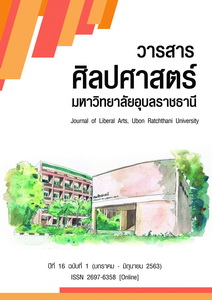การมีส่วนร่วมในการอภิปรายในชั้นเรียนของนักศึกษาไทยที่เรียนภาษาอังกฤษเป็นภาษาต่างประเทศ
Main Article Content
บทคัดย่อ
งานวิจัยนี้ เป็นการศึกษาการมีส่วนร่วมของนักศึกษาในการอภิปรายในชั้นเรียน (Discussion) ซึ่งเป็นรูปแบบการเรียนการสอนที่ไม่เพียงแต่สร้างโอกาสให้นักศึกษาได้เข้าถึง input ทางภาษา และนำไปสู่ความสามารถในการผลิต output เพียงเท่านั้น แต่ยังเป็นช่องทางที่ทำให้เกิดการพัฒนาทักษะทางด้านความคิดเชิงวิพากษ์ (Critical thinking skill) งานวิจัยเชิงคุณภาพนี้ ศึกษาลักษณะการมีส่วนร่วมของนักศึกษาในการอภิปรายในชั้นเรียน และเพื่อศึกษาความคิดเห็นของนักศึกษาในการเรียนแบบการอภิปรายในชั้นเรียน มีกลุ่มตัวอย่าง ได้แก่ นักศึกษาสาขาภาษาอังกฤษและการสื่อสาร คณะศิลปศาสตร์ มหาวิทยาลัยอุบลราชธานี ประเทศไทย จำนวนทั้งสิ้น 25 คน ที่เรียนรายวิชาทักษะการทำวิจัย ซึ่งเป็นวิชาเอกบังคับในหลักสูตร มีขั้นตอนการดำเนินการวิจัยโดยการสังเกตการณ์ในชั้นเรียนและการสัมภาษณ์ โดยเก็บข้อมูลการสังเกตการณ์ในชั้นเรียนจำนวน 8 ครั้ง ครั้งละ 3 ชั่วโมง รวมเป็นจำนวนทั้งสิ้น 24 ชั่วโมง ทั้งนี้ ผู้วิจัยได้สังเกตพฤติกรรมการมีส่วนร่วมของนักศึกษาในการอภิปรายทั้งในระดับห้องเรียนและระดับกลุ่มย่อย หลังจากนั้นได้ดำเนินการสัมภาษณ์นักศึกษาจากการสุ่มจำนวน 10 คน เพื่อสะท้อนความคิดเห็นในการเรียนการสอนแบบอภิปรายในชั้นเรียน และนำมาสู่ปัจจัยที่เป็นอุปสรรคของการเรียนการสอนแบบอภิปรายในชั้นเรียน จากการวิเคราะห์ข้อมูลพบว่า การอภิปรายในชั้นเรียนกระตุ้นให้นักศึกษาได้แลกเปลี่ยนความรู้และความคิดเห็นระหว่างกัน อย่างไรก็ตาม ระดับการมีส่วนร่วมของนักศึกษามีความสัมพันธ์เชื่อมโยงกับความแตกต่างขนาดของกลุ่ม ประเภทของคำถาม และประเภทของหัวข้อ รวมไปถึงปัจจัยภายในของนักศึกษา งานวิจัยพบว่า ความสัมพันธ์ระหว่างผู้สอนกับนักศึกษาและนักศึกษาด้วยกันเอง รวมไปพื้นความรู้ (Background knowledge) ส่งผลต่อระดับการมีส่วนร่วมในการอภิปรายในชั้นเรียนของนักศึกษา
Downloads
Article Details
เอกสารอ้างอิง
Blatchford, P. & Baines, E. (2010). Peer relation in school. In K. Littleton, C. Wood and Kleine Staarman (Eds) International Handbook of Psychology in Education. Bingley, UK: Emerald.
Brookfield, S., & Preskill, S. (1999). Discussion as a way of teaching: Tools and techniques for democratic classrooms. San Francisco: Jossey-Bass Publishers.
Bui, H.Y.G. (2014). Task readiness: Theoretical framework and empirical evidence from topic Familiarity, strategic Planning, and proficiency levels. In: P. Skehan (Ed.), Processing perspectives on task performance (pp. 63–94). Amsterdam: John Benjamins.
Bygate, M., Skehan, P., & Swain, M. (2001). Introduction. In M. Bygate, P. Skehan, & M. Swain (Eds.), Researching Pedagogic Tasks: Second Language Learning, Teaching and Testing (pp. 1-20). New York: Pearson Education Limited.
Education First. (2019). The world's largest ranking of countries and regions by English skills. Retrieved from https://www.ef.co.th/epi/
Ewens, W. 2000. Teaching using discussion. In Classroom communication: Collected readings for effective discussion and questioning, ed. R. Neff and M. Weimer, 21–26. Madison, WI: Atwood Publishing.
Hamm, J. V., & Faircloth, B. S. (2005). The role of friendship in adolescents’ sense of school belonging. New Directions for Child and Adolescent Development, 2005(107), 61–78.
Hartup, W. W. (1992). Friendships and their developmental significance. In H. McGurk (Ed.), Childhood social development: Contemporary perspectives (p. 175–205). Lawrence Erlbaum Associates, Inc.
Hayes, D. (2008). Becoming a teacher of English in Thailand. Language Teaching Research, 12(4), 471–494.
Hayes, D. (2010). Language learning, teaching and educational reform in rural Thailand: an English teacher’s perspective. Asia Pacific Journal of Education, 30(3), 305–319.
King J. (2016) Introduction to the Dynamic Interplay between Context and the Language Learner. In: King J. (eds) The Dynamic Interplay between Context and the Language Learner. Palgrave Macmillan, London
Krashen, S. D. (1981). Second language acquisition and second language learning. Oxford: Pergamon Press.
Kulsirisawad, P. (2012) Students’ perceptions on the integration of peer feedback on grammatical errors in the EFL writing classroom. Manutsat Paritat: Journal of Humanities. Forthcoming 2012.
Long, M. H. (1983). Native speaker/non-native speaker conversation and the negotiation of comprehensible input. Applied Linguistics, 4, 126–141.
Long, M. H. (1996). The role of the linguistic environment in second language acquisition. In W. C. Ritchie & T. K. Bhatia (Eds.), Handbook of second language acquisition (pp. 413–468). New York: Academic Press.
Mackey, A. (1999). Input, interaction, and second language development: An empirical study of question formation in ESL. SSLA, 21, 557-587.
Mackey, A. (2012). Input, interaction, and corrective feedback in L2 learning. Oxford: Oxford University Press.
Mustapha, S. M., Rahman, N. S. N. A., & Md Yunus, M. (2010). Factors influencing classroom participation: A case study of Malaysian undergraduate students. In Procedia - Social and Behavioral Sciences, 9, 1079-1084
National Institute of Educational Testing Service. (2019). O-Net Statistic. Retrieved from https://www.niets.or.th/th/catalog/view/3865
Pica, T., Lincoln-Porter. F., Paninos, F. & Linnell, J. (1996). Language learners’ interaction: How does it address input, output and feedback needs of L2 learners? TESOL Quarterly 30(1), 59-84
Rujivanarom, P. (2016). School system’s failure to teach logical thinking linked to low PISA scores. The Nation. Retrieved from http://tinyurl.com/ l68ugux
Stone, G. (2017). Implementation of Critical Literacy for English Writing Classes in the Thai Context. The New English Teacher, (11)2, 65-76.
Swain, M. (1985). Communicative competence: Some rules of comprehensible input and comprehensible output in its development. In S. Gass, & C. Madden (Eds.), Input in second language acquisition (pp. 235-253). Rowley, MA: Newbury House.
Swain, M., & Lapkin, S. (1995). Problems in Output and the Cognitive Processes They Generate: A Step towards Second Language Learning. Applied Linguistics, 16, 371-391.
Vygotsky, L. S. (1987). Thinking and speech. In R. W. Rieber & A. S. Carton (eds.)., The collected works of L. S.
Vygotsky, L. S. (1962). Thought and Word. In L. Vygotsky & E. Hanfmann, G. Vakar (Eds.), Studies in communication. Thought and language (p. 119–153). MIT Press.
Weaver, R. R., & Qi, J. (2005). Classroom Organization and Participation: College Students’ Perceptions. The Journal of Higher Education, 76(5), 570–601.
Witherspoon, M., Sykes, G., and Bell, C. (2016). Leading a Classroom Discussion: Definition, Supportive Evidence, and Measurement of the ETS National Observational Teaching Examination (NOTE) Assessment Series (Research Memorandum No. RM-16-09). Princeton, NJ: Educational Testing Service.


